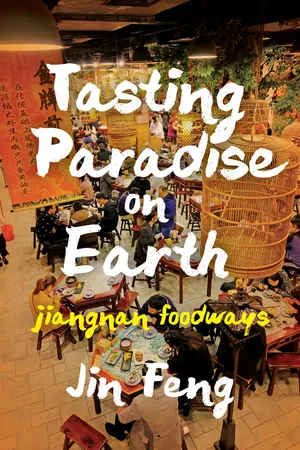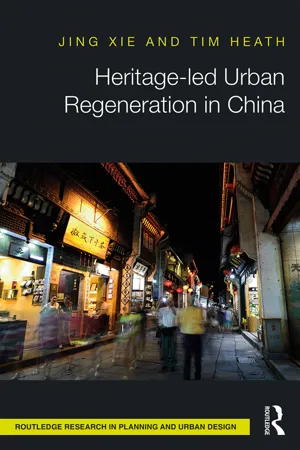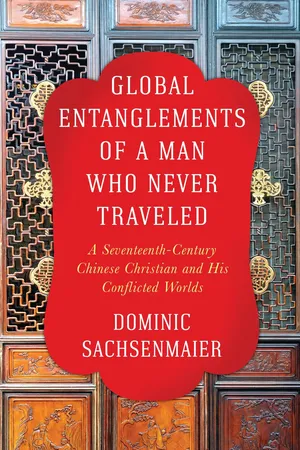History
Hangzhou
Hangzhou is a city in China with a rich historical significance. As the capital of the Southern Song Dynasty, it was a major political and cultural center. Renowned for its scenic West Lake and as a hub of trade and commerce, Hangzhou played a pivotal role in the development of Chinese civilization and continues to be a significant cultural and economic hub today.
Written by Perlego with AI-assistance
Related key terms
5 Key excerpts on "Hangzhou"
- eBook - ePub
Tasting Paradise on Earth
Jiangnan Foodways
- Jin Feng(Author)
- 2019(Publication Date)
- University of Washington Press(Publisher)
CHAPTER 4 Hangzhou The Fashionable CapitalT HE name Hangzhou immediately conjures up images of great natural beauty and cultural richness. After all, it boasts West Lake, the topic of numerous classical poems and essays throughout Chinese history; the “Ten Scenes of West Lake,” which include tourist favorites such as the Bai Causeway and the Su Causeway, built on the orders of poet and official Bai Juyi (772–846) and Su Shi; and popular stories, folk tales, and legends associated with Hangzhou as capital of the Wuyue kingdom in the Five Dynasties period (907–60) and later of the Southern Song.Compared to Suzhou, the other Chinese “paradise on earth,” which prides itself on its preservation of an uninterrupted history and pristine Jiangnan traditions, Hangzhou can lay claim to a past that exposed residents to both northern and southern Chinese culinary influences, which in turn bred eclectic food tastes. With Hangzhou assuming more administrative prominence as the provincial capital of Zhejiang, its restaurant industry fully embraces a market economy. In addition to the mercantile tradition of Zheshang (Zhejiang merchants), which advocates entrepreneurial spirit, the municipal government also feels a self-conscious need to lead the whole province through its example of carrying out the development-oriented economic policies of the state.1 Consequently, Hangzhou restaurants’ push for growth through enfranchisement and construction of food processing plants, and expansion in lines of processed and packaged foods has accelerated even more than in Suzhou.Local restaurateurs ingeniously tap into Hangzhou’s history as the capital of the Southern Song and at times evoke culinary traditions even more distant and misty than those of late imperial Suzhou. The municipal government and local entrepreneurs have long capitalized on Hangzhou’s history. Opening in 1996, the Song City (Song Cheng) Theme Park has now developed into a privately owned corporation with the name Song City World Land, which has built branches at famous tourist sites in other parts of China, including in Sanya, Lijiang, and Jiuzhaigou, advancing the Disneyfication of Hangzhou’s imperial heritage. Claiming to have combined “culture and tourism,” the theme park, which attracts an annual crowd of more than six million tourists, offers daily “romantic shows” introducing the culture of the Southern Song, various amusement parks featuring waterslides among other attractions, and a five-star hotel. In 2006, Song City also hosted the World Leisure Exposition supported by Xi Jinping, then the general secretary of the Zhejiang CCP committee, and purportedly “heralded the beginning of China’s leisure industry.”2 The city government also built a Southern Song Imperial Street based on archeological findings.3 Opened for business in 2009, the replica features historical buildings and museums but defines its mission as generating commerce and tourism. Thus, “old and famous” local shops such as Zhang Xiaoquan Scissors, Wang Xing Ji Fans, Qingyu Tang (the Hall of Plenty) Herbal Medicine, and Wufang Zhai (Five Fragrances House), a Zhejiang-originated maker of specialty dumplings (zongzi ), sit side by side with foreign chains including McDonald’s, Dairy Queen, Hä - 12. West Lake and the Southern SongHangzhou first gained national prominence during the short-lived Sui dynasty. When the Grand Canal was constructed in that era, the city became its southern terminus. Unlike Kaifeng, the Northern Song capital, which remained more or less a consumers’ market, with government functionaries and their associates providing most of the purchasing power, Hangzhou, the capital of the Southern Song, became a major manufacturing center. Shipbuilding, silk production, and porcelain- and paper-making increased dramatically in this city during the Southern Song.For the modern tourist, West Lake, within walking distance of the city, is a major attraction. Originally a shallow bay surrounded by mountains, it remained so as late as the early seventh century. But when its outlet to the mouth of the Qiantang River silted up a lake was formed, and the trapped water in time became desalinated.The lake is only slightly smaller than the city itself. Two causeways shorten the distance from points on the curved northwest and west shores. The Bai Causeway, named after Bai Juyi (p. 4), leads to the island of Solitary Hill. The Su Causeway is named in memory of Su Dongpo, the poet, painter, and prose-writer who in the eleventh century vigorously opposed Wang Anshi’s reforms. Although they lived almost 300 years apart, both Bai and Su became governor in the Hangzhou area and both ordered the dredging of the lake. The causeways are left from their works. The governments of traditional China had a point, although it may have been fortuitous, in their effort to recruit functionaries from among men of aesthetic tastes. They generally took better care of ecology and the environment than ordinary bureaucrats.A Chinese opera that is becoming well-known in the United States nowadays, The White Snake
- eBook - ePub
- Jing Xie, Tim Heath(Authors)
- 2017(Publication Date)
- Routledge(Publisher)
From the above description, it is clear that individual households could freely engage with Imperial Street by selling their services and goods. Driven by the common pursuit of commercial advancement, multiple social functions were therefore evident on Imperial Street. There was an intertwining of political and economic forces together with governmental and individual affairs. It is safe to assume that the barriers installed to eliminate the traffic were limited only to the front portion of the street connecting the Imperial Palace, therefore only slightly hampering the functioning of business activity. The physical demarcation of social hierarchy in the public street, that is, the imperative of differentiating the members of imperial court from the commoners, diminished further during the Southern Song period.The court was forced to flee from Kaifeng after it was conquered by the Jurchens in 1127 and after a prolonged struggle, the emperor Gaozong (高宗) officially denoted Hangzhou as the capital city in 1138.7 Its name was then changed to Lin’an (临安) which literally means a temporary settlement, reflecting the desire to recover the lost territory. As a result, Lin’an became the politic, economic and cultural centre of the Southern Song dynasty for about 140 years. Prior to becoming the capital known as Lin’an, Hangzhou was a prefecture city of the Northern Song dynasty, as well as the capital of the Wuyue Empire during the Five Dynasties (907–960). As such, it had enjoyed great prosperity which was further enhanced after its sanctification.8 Hangzhou’s pre-eminence over other cities in terms of commercial prosperity is acknowledged as the key factor leading to the final decision by the court regarding the options for relocation from Kaifeng.The Southern Song Imperial Palace in Hangzhou was built on the site of the existing elevated prefecture compound which was backed by the Phoenix Mountain in the south of the city. Compared to other capital cities (e.g. Chang’an, Luoyang and Kaifeng) in the preceding dynasties, the layout of Hangzhou was circumstantial. First and foremost, the city itself was shaped by the natural topography, that is, West Lake to the west and the Qiantang River to the east, thereby exhibiting an irregular and slender shape, in striking contrast to the ideal quadrangular form (Figure 3.3 ). The extreme southern location of the Imperial Palace also reflected the court’s fear of military invasions from the north. However, a sense of discretion was well disguised by literature that eulogised the site selection on the basis of the city’s natural topography. Indeed, as the Song scholar Zhao Yanwei (赵彦卫) stated in Yunlu manchao - eBook - ePub
- Jae Ho Chung(Author)
- 2005(Publication Date)
- Routledge(Publisher)
The city proper is situated less than 100 kilometres from the Bay of Hangzhou, where the Qiantang River, which flows through the south of the city from west to east, meets the sea. As the southern terminus of the Grand Canal, Hangzhou possesses convenient water access to the interior of the province, to the Great Lake (taihu) and beyond to the north, and via the coast to the rest of China and the world beyond. It is a major railway junction for lines east to Ningbo, north to Shanghai, and south through Jiangxi province to Guangzhou and other cities in the south and south-west of China. Despite its proximity to the ocean, Hangzhou suffers from an extreme climate with four well-defined seasons. Winter is dry and cold, and summer hot and humid. The city, including counties, covers a total area of 16,596 square kilometres. Two-thirds of the terrain is classified as mountains, 26 per cent plains, with rivers, and lakes and reservoirs making up the remaining 8 per cent. This topography accounts for the saying ‘seven parts mountain, one part water and two parts land’. Hangzhou has under its jurisdiction six urban districts, five county-level cities and two counties. The population density for the city as a whole was 360 persons per square kilometre. This was lower than the provincial average of 429 persons per square kilometre. Population density in the city districts, however, was as high as 3,338, with the old Upper City district having a population density of 31,592 persons per square kilometre, similar to that of Shanghai’s urban districts. 41 While the larger city covers an area of almost 16,600 square kilometres, the area of the city districts at 430 square kilometres (prior to the 1996 expansion) made Hangzhou the fourth smallest of all provincial capitals (and its GDP the fourth lowest), and the second smallest of cities with a population of over 1 million. 42 Hangzhou city proper is hemmed in on all sides, with little room for growth - eBook - ePub
Global Entanglements of a Man Who Never Traveled
A Seventeenth-Century Chinese Christian and His Conflicted Worlds
- Dominic Sachsenmaier(Author)
- 2018(Publication Date)
- Columbia University Press(Publisher)
1 A LOCAL LIFE AND ITS GLOBAL CONTEXTS NINGBO: BETWEEN CHINA AND THE WORLDZhu Zongyuan’s native city, Ningbo, is located at the mouth of the Bay of Hangzhou on China’s east coast. During the Ming dynasty, this city was part of Zhejiang province, just as it is today. At first sight, Ningbo might not have looked like an important transaction hub: it was surrounded by a thick wall more than eight meters high, and hardly any building in its center was taller than that.1 Yet for much of Ningbo’s history, this wall was less about preventing entry than about protecting the area inside as a place of intense encounters. In fact, as a port in a region with intensive commerce, the city was more connected to long-distance trading routes than were most other Chinese cities with a comparable population. For many centuries, Ningbo played an important role in the exchange networks connecting the lower Yangtze region with China’s vast compound canal system as well as the ocean. All kinds of goods passed through its port, including iron, ivory and pepper from the south, silk from the north, timber from Japan, and porcelain, lacquer, and paper made for overseas trade.2After a period of relative decline, Ningbo’s significance rose again in the sixteenth century when the central government loosened restrictions on foreign trade and the harbor of nearby Hangzhou, one of China’s largest regional metropoles, started to silt up.3 In the latter half of the Ming dynasty, a number of factories, including some export-oriented ones, were established in Ningbo. Further evidence of the city’s burgeoning wealth were the seven new merchant towns founded in the city’s immediate vicinity between 1487 and 1560. During this period, Zhu Zongyuan’s hometown was once again one of China’s key ports—a status it kept with few interruptions until the early twentieth century. It also grew into a highly developed financial center and became the seat of major government offices.4
Learn about this page
Index pages curate the most relevant extracts from our library of academic textbooks. They’ve been created using an in-house natural language model (NLM), each adding context and meaning to key research topics.




